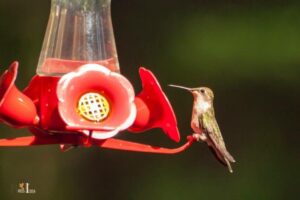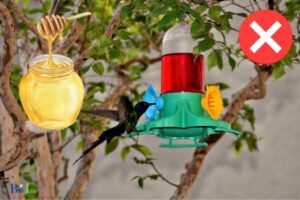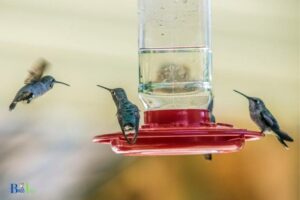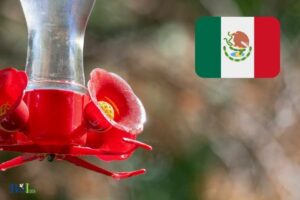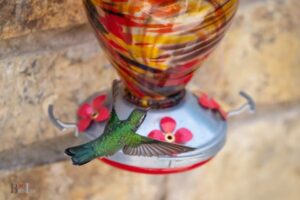DIY Hummingbird Feeder Mason Jar: 10 Materials!
Creating a DIY hummingbird feeder with a mason jar can be a simple, cost-effective and environmentally-friendly way to attract these beautiful birds to your garden.
All you need is a mason jar, some sugar, water, and a feeder attachment for the jar, which you can purchase online or at a local bird store.
A DIY hummingbird feeder made from a mason jar is an eco-friendly and cost-effective way to attract hummingbirds to your garden.
Creating a DIY mason jar feeder is an easy and simple project that helps to reduce waste by repurposing a household item.
Additionally, it provides a feeding spot for hummingbirds, encouraging these beautiful creatures to visit your garden and contributing to their nourishment and well-being.
10 Materials Needed for DIY Hummingbird Feeder Mason Jar
| Material Needed | Quantity | Description |
| Mason Jar | 1 | Used as the main body of the feeder, should be clear to monitor nectar level |
| Sugar | 1 cup | For making homemade nectar |
| Water | 4 cups | For making homemade nectar |
| Red Ribbon | 1 | To attract hummingbirds |
| Metal Tube | 1 | For the feeding port |
| Metal Lid | 1 | To be fit on the mason jar |
| Wire | 1 | For hanging the feeder |
| Drill | 1 | To make a hole on the lid for the feeding port |
| Paint (non-toxic) | As needed | Optional for decorating the jar |
| Brush | 1 | Optional for applying the paint |
Key Takeaway
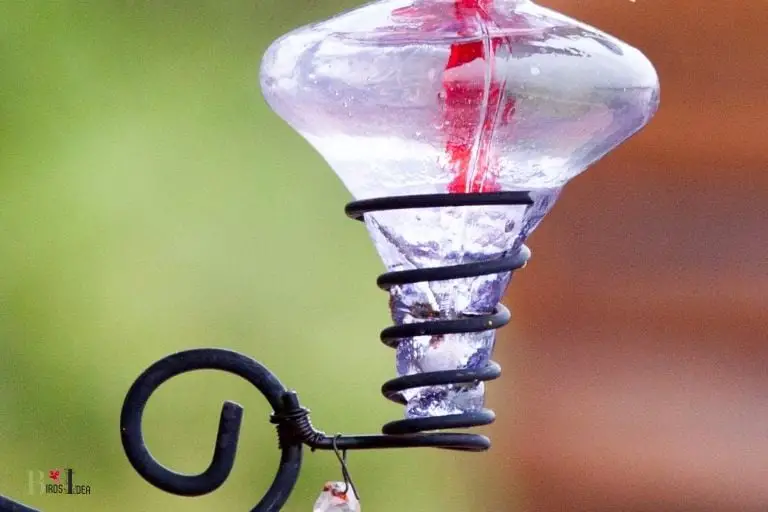
Five Facts About: DIY Hummingbird Feeder Mason Jar
How to Make a DIY Hummingbird Feeder with a Mason Jar?
Creating a DIY hummingbird feeder with a mason jar is a simple and low-cost way to attract these fascinating creatures to your backyard.
Not only will it provide a source of food for the hummingbirds, but it can also serve as a beautiful and functional decoration for your outdoor living space.
To make this charming feeder, you’ll need a few supplies and follow some easy steps:
- Mason jar with a lid
- Hummingbird feeder tube with a stopper
- Sugar
- Water
- Red food coloring (optional)
- Twine or wire for hanging
- Decorative elements (optional)
Step 1: Prepare the nectar
- Combine 1 part sugar with 4 parts water in a pot.
- Bring the mixture to a boil, stirring until the sugar is completely dissolved.
- Once the sugar-water mixture has cooled, you can add a few drops of red food coloring if desired. This is optional, as hummingbirds are naturally attracted to the color red.
Step 2: Assemble the feeder
- Drill or punch a hole in the center of the mason jar lid, large enough for the hummingbird feeder tube to fit through.
- Insert the feeder tube into the hole, ensuring a snug fit to prevent leaks. The stopper should be on the inside of the lid, and the feeding end should stick out from the top.
- Fill the mason jar with the prepared nectar, leaving about an inch of headspace.
- Screw the lid with the feeder tube onto the jar, making sure it is tight and secure.
Step 3: Add decorations and hang the feeder
- Decorate the outside of the jar with paint, ribbon, or other embellishments if desired. This is optional but can add a personalized touch to your hummingbird feeder.
- Attach twine or wire around the neck of the jar for hanging.
- Hang the feeder in a spot that is easy for hummingbirds to access, ideally near flowers or plants that they are naturally drawn to.
What Supplies Are Needed to Create a Mason Jar Hummingbird Feeder?
Creating a Mason jar hummingbird feeder is a simple and cost-effective way to attract these beautiful birds to your garden.
Not only is this DIY project environmentally friendly, but it also allows you to customize the design to suit your personal tastes and preferences.
To get started, you’ll need to gather the necessary supplies:
- A clean Mason jar (16 oz or larger)
- A hummingbird feeder lid with a feeding tube or a hummingbird feeder stopper
- Glass or metal wire (for hanging)
- Nectar (either homemade or store-bought)
- Hot glue gun
- Optional: decorative elements (paint, ribbon, etc.)
Once you have your supplies ready, you can begin assembling your Mason jar hummingbird feeder.
Here are the steps to follow:
- Clean and thoroughly dry the Mason jar.
- Attach the hummingbird feeder lid to the jar securely.
- Fill the jar with nectar, either homemade or store-bought.
- If you’d like, decorate the jar with paint, ribbon, or other embellishments, but be cautious not to use toxic materials since they might harm the birds.
- Using the glass or metal wire, create a loop or hanger to suspend the feeder outdoors.
- Hang the feeder in a safe location, preferably near flowers, and enjoy watching hummingbirds visit your new creation!
To make your own nectar at home, combine 1 part granulated sugar with 4 parts boiling water.
Stir until the sugar dissolves completely and allow the mixture to cool before filling the feeder. Avoid using artificial coloring or honey, as they can be harmful to hummingbirds.
“Hummingbirds are not only fascinating to watch but also important pollinators in our ecosystem. Creating a DIY hummingbird feeder with a mason jar is a great way to provide food and shelter for these amazing birds.”
BirdWatchingHQ
What Should You Include in Your DIY Mason Jar Hummingbird Feeder?
A DIY Mason Jar Hummingbird Feeder is an easy, cost-effective, and creative way to attract hummingbirds to your garden.
By repurposing a mason jar, you can create a functional and stylish feeder that hummingbirds will love to visit.
To make your own hummingbird feeder, you should include a few essential components that will ensure the birds can easily access the nectar while keeping it fresh and clean.
- Mason jar with a tight-fitting lid
- Feeding tube with a red flower-shaped end or red feeding ports
- Hanging mechanism (wire or twine)
- Hummingbird nectar (homemade or store-bought)
- Optional: decorative elements, such as colored glass beads or paint
To create your feeder:
- Clean the mason jar thoroughly to remove any residue.
- Drill a hole in the center of the lid, large enough to fit the feeding tube.
- Insert the feeding tube through the hole in the lid, making sure it fits snugly.
- Fill the jar with hummingbird nectar, leaving some space at the top to prevent overflow.
- Attach the lid tightly to the jar, ensuring the feeding tube is submerged in the nectar.
- Attach the hanging mechanism to the jar, making sure it’s secure and balanced.
- Optional: add decorative elements to the exterior of the jar for a personalized touch.
- Hang the feeder in a shady spot in your garden, ideally near flowering plants hummingbirds are attracted to.
How to Clean and Maintain a Mason Jar Hummingbird Feeder
Cleaning and maintaining a mason jar hummingbird feeder is essential to ensure the health and safety of the visiting hummingbirds.
Proper maintenance will prevent mold and bacteria growth, which can be harmful to the birds. A clean feeder will also attract more hummingbirds to your yard.
To maintain this feeder, it is important to clean it regularly, ensure that the nectar is fresh, and inspect the feeder for any damages or defects.
- Regular cleaning: Disassemble the mason jar hummingbird feeder and clean every part with warm soapy water. Use a small brush to remove any residue or dirt, especially in hard-to-reach areas. Rinse thoroughly and let the parts dry.
- Fresh nectar: Change the nectar every 3-5 days, or more often in hot weather. Hummingbirds prefer fresh nectar, and it will prevent mold and bacteria growth in the feeder.
- Inspection: Check the feeder for any damages, cracks, or leaks that might make it less effective. Replace damaged parts as needed to keep the feeder in good condition.
- Placement: Place the feeder in a shaded area to prevent the nectar from spoiling too quickly, and out of reach of predators such as cats and squirrels.
Advantages & Disadvantages of Making a Hummingbird Feeder from a Mason Jar
A hummingbird feeder made from a mason jar can be a cost-effective and eco-friendly way to attract these beautiful birds to your garden.
There are several advantages and disadvantages that you should consider before embarking on this DIY project.
Advantages:
- Cost-effective: Using a mason jar that you already have at home can save you money compared to purchasing a store-bought feeder.
- Environmentally friendly: Repurposing a mason jar means fewer materials go to waste.
- Customizable: You can decorate your mason jar hummingbird feeder however you please, making it unique to your yard.
- Easy to clean and refill: The wide mouth of a mason jar makes it simple to clean and refill with nectar.
Disadvantages:
- Potential for leaks: If the seal between the mason jar and the feeder attachment isn’t tight, nectar may leak, attracting ants and other pests
- Glass breakage: Mason jars can be fragile, and a fall or strong impact could result in broken glass and potential harm to birds or other wildlife.
- Weight: Mason jars can be heavy, which may make it challenging to hang securely from delicate branches or other areas where hummingbirds frequent.
- Limited options for feeder attachments: There may be fewer options for feeder attachments and ports compatible with mason jars compared to store-bought hummingbird feeders.
DID YOU KNOW
According to the Audubon Society, hummingbirds flap their wings up to 70 times per second and can fly up to 60 miles per hour. They also consume twice their body weight in nectar every day!
birdsidea
What to Know Before You Make a Mason Jar Hummingbird Feeder?
Before making a mason jar hummingbird feeder, it’s essential to consider some critical factors that can impact the attractiveness and safety of the feeder for hummingbirds.
These factors include the type of feeder, color, nectar recipe, and feeder maintenance.
By paying attention to these elements, you can create a homemade hummingbird feeder that attracts and nourishes these delightful creatures while also being decorative and eco-friendly.
- Type of feeder: Mason jar hummingbird feeders should have a base that is specifically designed for hummingbirds, with holes small enough to discourage bees and other unwanted insects.
- Feeder color: Hummingbirds are typically attracted to brightly colored feeders, particularly red and orange hues. Incorporating these colors into your mason jar feeder will make it more appealing to hummingbirds.
- Nectar recipe: Homemade nectar should consist of a simple sugar and water mixture. Use a ratio of 1 part sugar to 4 parts water. Boil the water, dissolve the sugar, and let it cool before adding it to the feeder.
- Feeder maintenance: To ensure the safety and health of the hummingbirds, clean the feeder regularly with hot water and mild soap.
Video About: Diy Hummingbird Feeder Mason Jar?
How do you make a DIY hummingbird feeder?
Making a DIY hummingbird feeder using a mason jar is a fun and easy project that can be completed in a few simple steps.
Here’s how you can do it:
- Start by cleaning a mason jar thoroughly, making sure it’s free from any residue or dirt.
- Drill a hole in the center of the mason jar lid, big enough to fit the hummingbird feeder spout.
- Thread the feeder spout through the hole and secure it in place with the included washers and nut.
- Fill the jar with nectar, which can be made by combining four parts water with one part white granulated sugar. Stir until the sugar dissolves.
- Screw the lid back on the jar, and your DIY hummingbird feeder is ready to hang up.
By making your own feeder, you’ll not only save money, but you’ll also be able to customize it to fit your style and preferences. Enjoy watching the hummingbirds come to feed at your handmade creation!
What is the liquid mixture for hummingbird feeder?
To make a cheap hummingbird feeder using a mason jar, you will need the following materials:
- A clean mason jar with a lid
- Two-part hummingbird feeder base
- Drill with 7/64 drill bit
- Copper wire or metal hanger
- Red ribbon or paint (optional)
Once you have gathered all the materials, follow these steps to make a hummingbird feeder:
- Drill a hole in the center of the lid using a 7/64 drill bit.
- Thread the base’s clear tube through the hole in the mason jar’s lid.
- Screw the base tightly onto the clear tube from the bottom of the lid.
- Bend and twist the copper wire or hanger into a hanger shape and attach it to the jar’s neck.
- (Optional) If you want to attract hummingbirds better, paint the lid with red paint or tie a red ribbon around the lid.
Your cheap and simple hummingbird feeder using a mason jar is now ready to hang outside!
How do you make a cheap hummingbird feeder?
To fill a hummingbird feeder using a mason jar, first, ensure that the jar is clean and free of any residue or soap.
Then, follow these steps:
- Unscrew the metal lid of the mason jar and drill a hole in the center of it.
- Thread a hummingbird feeder spout through the hole, ensuring that it fits snugly.
- Fill the jar with the hummingbird nectar and screw the lid back on.
- Turn the jar upside down, and the nectar will flow out through the spout, filling the feeder with ease.
Using a mason jar as a hummingbird feeder can be a fun DIY project and a great way to attract these fascinating birds to your garden.
Just make sure to clean the feeder regularly and change the nectar frequently to keep the hummingbirds healthy and happy.
What is the easiest to fill a hummingbird feeder?
If you don’t have a hummingbird feeder, no need to worry, there are still some things you can use to attract these beautiful birds.
Here are some DIY ideas for hummingbird feeders that you can make at home using a mason jar:
- Use a mason jar with a lid to create a makeshift feeder. Drill or punch a hole in the center of the lid and insert a plastic or metal straw. Then, make four more holes around the center hole and insert the straws at an angle, so they act as perches for the birds to rest on. Fill the jar with a hummingbird nectar made using a ratio of four parts water to one part granulated sugar.
- Use a glass bottle with a cork or a stopper. Drill a small hole in the cork or stopper and insert a plastic or metal straw. Then, make four more holes around the center hole and insert the straws at an angle. Fill the bottle with hummingbird nectar and hang it in a shady area.
- Make a hummingbird feeder using a recycled plastic container. Cut a hole in the center of the lid and insert a plastic or metal straw. Then, make four more holes around the center hole and insert the straws at an angle. Fill the container with hummingbird nectar and hang it outside.
These DIY hummingbird feeders are easy to make and use materials that you may already have at home.
What can I use if I don’t have a hummingbird feeder?
If you are planning to make a DIY hummingbird feeder using a mason jar, you may be wondering whether to use a glass or plastic feeder.
Both materials have their pros and cons, so it ultimately comes down to personal preference. Here are some factors to consider:
Pros of a glass hummingbird feeder:
- Durable and long-lasting
- Easy to clean and maintain
- Glass does not discolor or scratch easily
- Better insulation to keep nectar fresh
Pros of a plastic hummingbird feeder:
- Lightweight and easier to handle
- Less expensive than glass feeders
- Comes in a variety of colors and styles
- Unbreakable and safe for outdoor use
When choosing between a glass or plastic feeder, consider your budget, personal style, and the level of durability you desire.
Ultimately, as long as the feeder is clean, filled with fresh nectar, and positioned in a safe and visible location, hummingbirds will happily visit either type of feeder.
FAQ of DIY Hummingbird Feeder Mason Jar
What type of mason jar should I use for a DIY hummingbird feeder?
What should I put in my DIY hummingbird feeder?
How should I hang the DIY hummingbird feeder?
How often should I clean and refill my DIY hummingbird feeder?
Conclusion
In conclusion, making a DIY hummingbird feeder with a mason jar is an easy and affordable way to attract these beautiful birds to your yard.
With the right supplies and a little effort, you can create a unique and functional feeder that is both practical and decorative.
Don’t forget to include the necessary components such as perches and nectar containers, and be sure to clean and maintain your feeder regularly to ensure the health and safety of your feathered visitors.
By following these tips and guidelines, you can enjoy the company of hummingbirds all season long.

